Tuesday, August 16, 2005
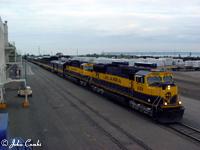 Randy
and I stop into the depot to visit a favorite employee.
Susie Kiger, Sales and Marketing Manager, meets us with a smile and a few goodies.
Her sunshiny personality exudes warmth and friendliness. As it turns out, Susie
and I have something in common. We both have new homes, but spend very little
time in them. In essence we agree that we have, "purchased nice homes for
our pets to live in." Susie leaves us to the depot gift shop and we promptly
purchase $200 worth of stuff.
Randy
and I stop into the depot to visit a favorite employee.
Susie Kiger, Sales and Marketing Manager, meets us with a smile and a few goodies.
Her sunshiny personality exudes warmth and friendliness. As it turns out, Susie
and I have something in common. We both have new homes, but spend very little
time in them. In essence we agree that we have, "purchased nice homes for
our pets to live in." Susie leaves us to the depot gift shop and we promptly
purchase $200 worth of stuff.
Our next friendly face is that of Curt Rudd, Anchorage Terminal
Superintendent. He takes us to meet with the security folks, Dan Frerich, Director
of Police & Security & Chief Special Agent and Tim Allen, Manager of
Port and Homeland Security. I find out they are both former military OSI (Office
of Special Investigations) agents. Back at my job at Wright-Patterson Air Force
Base I work with OSI agents all the time so I feel right at home with these
guys. They inform Randy and I of the various rules and safety procedures. Then
it is off to sign the necessary release forms and receive our yard passes.
 Curt
then takes us on a tour of the new $10 million Anchorage Operations Center (AOC).
It is impressive to see a building where the pre-construction phase was so well
thought out. For example, returning train crews typically enter the rear of
the building where a sink, washing machine and dryer stand ready. Crews can
then go to the crew center where restrooms, showers and crew lockers are available
for both men and women.
Curt
then takes us on a tour of the new $10 million Anchorage Operations Center (AOC).
It is impressive to see a building where the pre-construction phase was so well
thought out. For example, returning train crews typically enter the rear of
the building where a sink, washing machine and dryer stand ready. Crews can
then go to the crew center where restrooms, showers and crew lockers are available
for both men and women.
As we tour the various offices and breakrooms, it comes as
a complete surprise that some of the workers already know me from my website.
Several of the office computers are even using my photos as screen savers. This
makes my head swell so big that I begin having problems getting it through doorways.
Next, we journey through the second floor offices meeting the
various big kahunas of Alaska rail operations. Much swapping of business cards
takes place. We also tour the dispatcher's area where Ed Verlanic gives a drop
dead awesome demo showing how the railroad tracks its locomotive's precise location
using GPS. This all fits into the collision avoidance system the railroad is
working on. Finally, we head to the third floor for a look at the operations
tower. In a room where almost all the walls are windows, Gary Phillips vigorously
works on freight line-ups in the yard. Dale Greth, Customer Service Representative,
is involved in a heavy duty phone call, but is able to go into multiplex mode
and assist us with finding information on some hoppers Randy wants to model.
Our last stop is an open air dining area complete with barbeque grill. This
facility is light years beyond the old
yard tower/office that was demolished back in 1997!
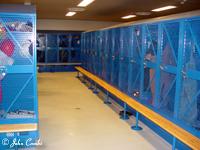 |
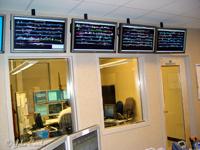 |
 |
| Men's crew lockers are spacious and accommodate padlocks |
Dispatcher's screens showing the location of all train traffic |
Trainmaster Gary Phillips surveys freight cars in the yard |
Hopping in Curt's truck, we tour the relatively new Flint Hills
balloon track where refined tank car products get unloaded and stored for reuse.
I then beg Curt to take us past the nearby Northland and Lynden trailer on flatcar
(TOFC) facility. Impressive giant cranes move container freight with computerized
perfection. I could sit and watch the loading and unloading process all day.
Unfortunately, Curt has another appointment to keep and so drops us off at our
car. So far, it's been an awesome day!
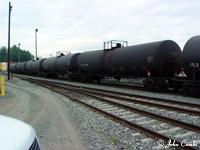 |
 |
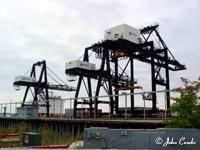 |
| Tank cars on the new Flint Hills balloon track |
Large ships are loaded with containerized freight |
Huge cranes take care of the loading and unloading process |
We return to the national archives to pick up our photocopies
and find the bill totals $177.30! Fortunately, only $28 of it is mine. Ha, ha,
ha! We run a few errands in town and then head to Whittier to catch the weekly
barge. Stopping briefly at Portage, we take a few quick pix of MOW train remnants
LC 110 and caboose 1074.
By 3:30 pm we are heading through the $80 million boondoggle,
the Anton Anderson Memorial Tunnel to the town of Whittier. Popping through
the other end of the two mile shaft, we see the weekly barge from Seattle has
already arrived. As we approach the barge area we find that operations have
changed radically. Now there is a fence around the entire area and access is
controlled by Purcell security. Fortunately for us, our name is on the preferred
visitor's list. Ba da bing! We drive down to the barge and spend the next 30
minutes taking photos of its contents.
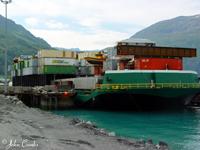 |
 |
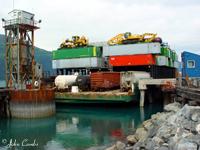 |
| Rear view of the loaded barge... |
side view... |
front view... |
When I was here was in the summer of 2002 the barges mostly
consisted of freight cars. The new barges now have a lower level for railcars
and an upper level for containerized freight. As if that isn't enough, extensions
will soon be added so the barge can transport even more containers! Anyway,
the yard has also expanded and mountains of container freight are everywhere.
It is very obvious that COFC traffic is the wave of the future for the Alaska
Railroad.
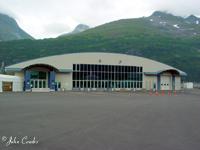 Since
it appears it will be a while before the unloading process begins, Randy and
I head over to see to the harbor office to see if our friend Harbormaster Mark
Earnest is there. As luck would have it, he is not. However, his assistant calls
him on his cell phone and sets up a 9:45 pm meet. We then stop by the new (relatively)
cruise ship depot and take a couple of snapshots. Our growling stomachs then
sent us to the old Anchor Inn where Halibut and Chips are served by a tattooed
waitress with black corkscrew hair hanging down to her nose. She apologizes
for the Halibut being a day and a half old. You could have fooled me. It is
absolutely fantastic!
Since
it appears it will be a while before the unloading process begins, Randy and
I head over to see to the harbor office to see if our friend Harbormaster Mark
Earnest is there. As luck would have it, he is not. However, his assistant calls
him on his cell phone and sets up a 9:45 pm meet. We then stop by the new (relatively)
cruise ship depot and take a couple of snapshots. Our growling stomachs then
sent us to the old Anchor Inn where Halibut and Chips are served by a tattooed
waitress with black corkscrew hair hanging down to her nose. She apologizes
for the Halibut being a day and a half old. You could have fooled me. It is
absolutely fantastic!
Returning to the barge, we bump into Trainmaster Jason who
Randy knows from his baggage handling days. Jason gives us an excellent safety
briefing designed to keep us safe while we photograph and video tape the unloading
process. "Just don't get run over!" he jokes.
The barge unloading begins at 6:18 pm and the freight railcars
are the first to go. [click
here to view the 1.8MB video] After one track is unloaded, a worker in a
blue booth directs giant cables attached to the barge so the next track is lined
up to unload. At one point, the unloading process slows to a crawl as a depressed
center flatcar moves over the unloading ramp. The distance between the pavement
and the bottom of the flatcar decreases to an almost nonexistent space. The
Trainmaster watches very closely until the flatcar completely offloads. The
unloading continues at a steady pace and by 7:20 pm all the freight cars are
gone.
 |
 |
 |
| Locomotives aren't permitted on barges so they use gondolas to reach for
the consist. |
The two towers hold weights used to raise and lower the ramp with the
tide. |
Notice how the barge leans to one side as the loads are removed. |
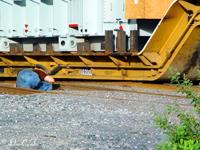 |
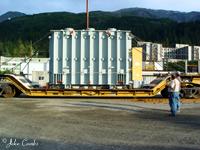 |
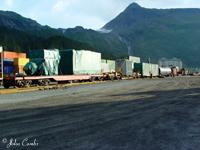 |
| A spotter checks the clearance of the depressed center flatcar. Yes, it
is very close! |
Randy Thompson and an unknown worker check out this very unusual load. |
Once the consist fills the unloading track, they are moved to another
siding. |
Now the longshoremen jump into action. Using giant forklifts
they go into a synchronized ballet of unloading the container freight from the
top deck of the barge. It is amazing to watch them gracefully unload a container
from the front port side, quickly pass by the forklift unloading the front starboard
side and then pass the container onto a smaller forklift that will load it onto
a railroad flatcar. The whole process is free of mistakes and wasted motion.
[click here for 3.4MB
video and here for 2.4MB
video]
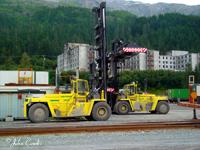 |
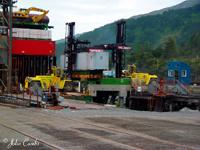 |
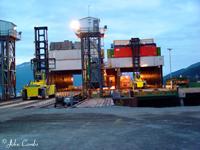 |
| The taller forklift removes the container from the barge while the shorter
one puts it on a flatcar. |
A metal deck is was put in place to protect the concrete pad and enable
easier transfer. |
A total of five forklifts are used. One tall forklift works the left while
the other works the right. |
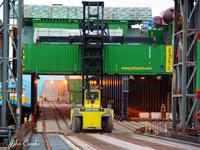 |
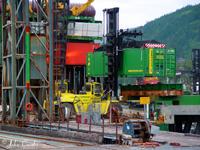 |
 |
| Step 1: A tall forklift gently removes the container from the top of the
barge. |
Step 2: Staying clear of the other forklift, he moves to the pad and gently
puts it down. |
Step 3: The shorter forklift picks up the container and transfer it to
a railroad flatcar. |
At 9:40 pm Randy and I head to the harbor office to await the
arrival of Mark. He is still not there by 9:50 pm and Randy wants to hit the
road so I leave and note and we head for the tunnel. Unbeknownst to us, as we
enter the tunnel, Mark is exiting the tunnel. He calls my cell phone to tell
me he is on his way and I break the bad news that we have just crossed paths.
Before I can finish our conversation, the call is cut off by the tunnel's rock
walls.
The return drive is uneventful and I spend the time complaining
to Randy about a problem I am having with one of the adult leaders in my Boy
Scout troop. We return to Don's around 11:30 pm and immediately become friends
with our pillows.
Day 2 | Index
| Day 4
 Randy
and I stop into the depot to visit a favorite employee.
Susie Kiger, Sales and Marketing Manager, meets us with a smile and a few goodies.
Her sunshiny personality exudes warmth and friendliness. As it turns out, Susie
and I have something in common. We both have new homes, but spend very little
time in them. In essence we agree that we have, "purchased nice homes for
our pets to live in." Susie leaves us to the depot gift shop and we promptly
purchase $200 worth of stuff.
Randy
and I stop into the depot to visit a favorite employee.
Susie Kiger, Sales and Marketing Manager, meets us with a smile and a few goodies.
Her sunshiny personality exudes warmth and friendliness. As it turns out, Susie
and I have something in common. We both have new homes, but spend very little
time in them. In essence we agree that we have, "purchased nice homes for
our pets to live in." Susie leaves us to the depot gift shop and we promptly
purchase $200 worth of stuff. 





















